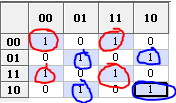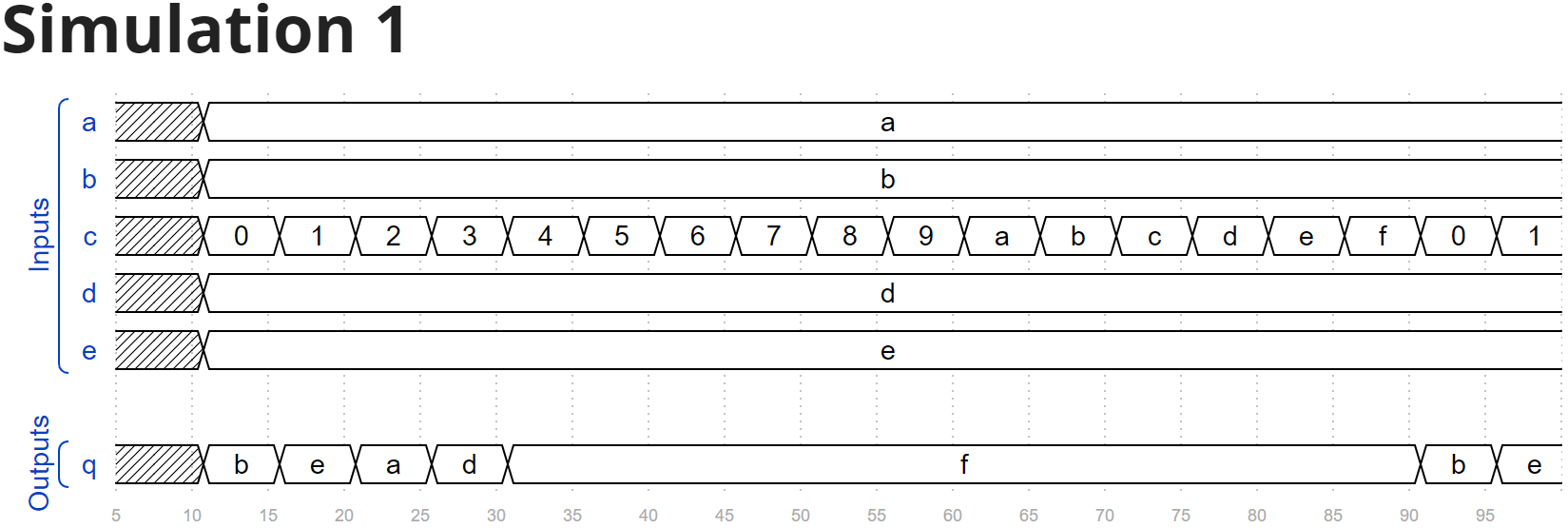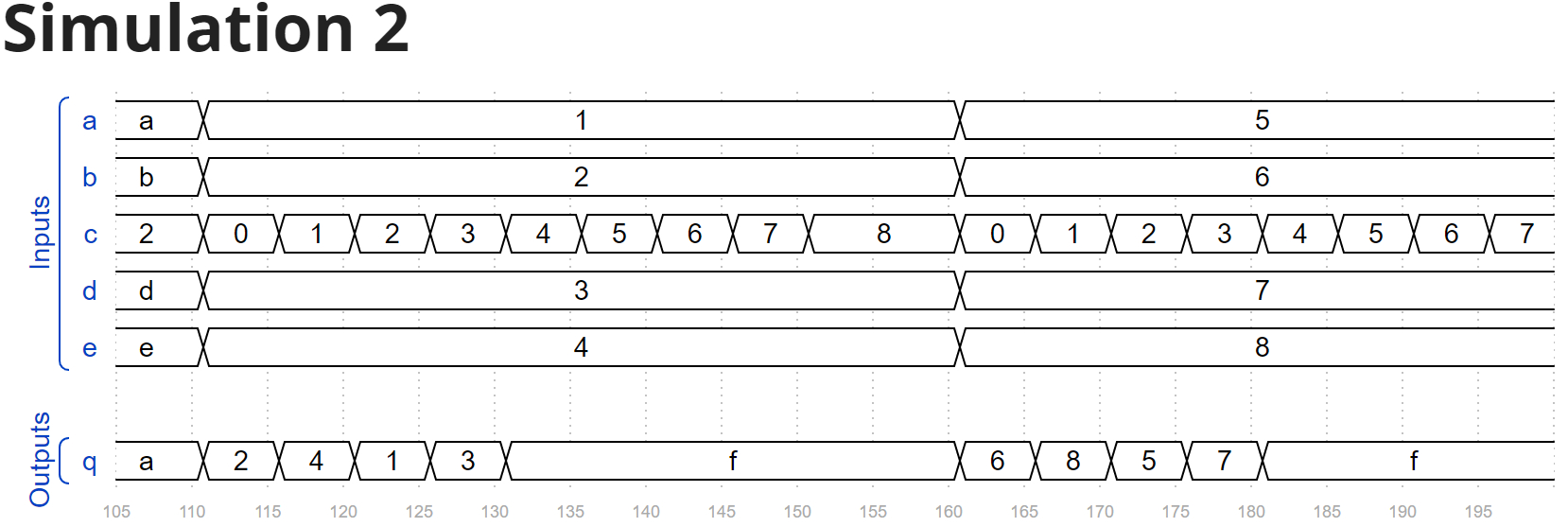写在前面
全部答案汇总:刷完这套题,我才发现Verilog原来如此简单----HDLBits答案汇总
今天更新Circuits章节中Verification:Reading Simulation的1个小节:Build a circuit from a simulation waveform
这个章节的内容是根据波形图编写Verilog代码,从波形图到硬件描述语言的转变是FPGAer的基本功(核心),而且在信号多、时序复杂的项目中读懂波形图更是一项一定要熟练掌握的能力。
Combinational circuit 1
【题目】:
根据下面的时序图实现这个组合逻辑电路。

【个人思路】:
从上面的q输出为1处,可以看到a、b均为1,所以逻辑是 a & b.
module top_module (
input a,
input b,
output q );//
assign q = a & b; // Fix me
endmoduleCombinational circuit 2
【题目】:
根据下面的时序图实现这个组合逻辑电路。

【个人思路】:
这个时序图稍微复杂点,最好是列出卡诺图,如下:

红色部分的四个数据,可以看出来是 ( a同或b ) 与上 ( c同或d );
蓝色部分的四个数据,可以看出来是 ( a异或b ) 与上 ( c异或d );
红色+蓝色 = ( a异或b ) 同或( c异或d ) =~a^b^c^d;
module top_module (
input a,
input b,
input c,
input d,
output q );//
//assign q = 1-a^b^c^d;
assign q = ~a^b^c^d;
endmoduleCombinational circuit 3
【题目】:
根据下面的时序图实现这个组合逻辑电路。

【个人思路】:
这个时序图稍微复杂点,最好是列出卡诺图,如下:
像我这样框起来:红色:b | d;黄色:b | c;黑色:a | d;绿色:a | c;
module top_module (
input a,
input b,
input c,
input d,
output q );//
assign q = b & d | b & c | a & d | a & c;
endmoduleCombinational circuit 4
【题目】:
根据下面的时序图实现这个组合逻辑电路。

【个人思路】:
这个时序图稍微复杂点,最好是列出卡诺图,如下:
红色:c;绿色:b;所以化简为 b | c。
module top_module (
input a,
input b,
input c,
input d,
output q );//
assign q = b | c; // Fix me
endmoduleCombinational circuit 5
【题目】:
根据下面的时序图实现这个组合逻辑电路。


【个人思路】 :
可以看出这是一个4输入、1输出的组合电路,且输出是根据c的取值来的,所以这个是个4选1电路(MUX4),所以可以用case语句来根据c的取值来进行输出。
module top_module (
input [3:0] a,
input [3:0] b,
input [3:0] c,
input [3:0] d,
input [3:0] e,
output [3:0] q );
always@(*)begin
case(c)
4'd0: q = b;
4'd1: q = e;
4'd2: q = a;
4'd3: q = d;
default: q = 4'hf;
endcase
end
endmoduleCombinational circuit 6
【题目】:
根据下面的时序图实现这个组合逻辑电路。

【个人思路】 :
可以看出这是一个根据输入a的取值来进行输出的组合电路,可以用case语句来根据a的取值来进行输出。
module top_module (
input [2:0] a,
output [15:0] q );
always@(*)begin
case(a)
3'd0: q = 16'h1232;
3'd1: q = 16'haee0;
3'd2: q = 16'h27d4;
3'd3: q = 16'h5a0e;
3'd4: q = 16'h2066;
3'd5: q = 16'h64ce;
3'd6: q = 16'hc526;
3'd7: q = 16'h2f19;
default:;
endcase
end
endmoduleSequential circuit 7
【题目】:
根据下面的时序图实现这个时序逻辑电路。

【个人思路】 :
可以看出输出q是输入a的取反,因为是时序逻辑,所以输出落后输入一个时钟周期。
module top_module (
input clk,
input a,
output q );
always@(posedge clk)begin
if(a)
q <= 1'b0;
else
q <= 1'b1;
end
endmoduleSequential circuit 8
【题目】:
根据下面的时序图实现这个时序逻辑电路。

【个人思路】 :
由图可见,p为a在clock为高电平时的选通信号,q为clock下降沿触发的信号,存放p的值。
module top_module (
input clock,
input a,
output p,
output q );
always@(*)begin
if(clock)
p <= a;
else
p <= p;
end
always@(negedge clock)begin
q <= p;
end
endmoduleSequential circuit 9
【题目】:
根据下面的时序图实现这个时序逻辑电路。

【个人思路】 :
可以看出这是一个~a使能的0~6计数器,a高电平时计数器复位到4.
module top_module (
input clk,
input a,
output [3:0] q );
always@(posedge clk)begin
if(~a)begin
if(q == 4'd6)
q <= 4'd0;
else
q <= q + 1'b1;
end
else
q <= 4'd4;
end
endmoduleSequential circuit 10
【题目】:
根据下面的时序图实现这个电路,该电路包含组合逻辑和D触发器。

【个人思路】 :
可以看到当输出q为高电平时,a、b、state三个中总是有奇数个高电平,所以q是a、b、state三个的偶校验位:q = a ^ b ^ state;
再来观察state的变化,state的变化都发生在(a == b)时,且变化的值为a(或者说b),当a不等于b时,state保持不变。
module top_module (
input clk,
input a,
input b,
output q,
output state );
assign q = a ^ b ^ state;
always @(posedge clk)begin
if(a == b)
state <= a;
else
state <= state;
end
endmodule最后
以上就是魁梧大门最近收集整理的关于刷完这套题,我才发现Verilog原来如此简单----HDLBits答案系列 -- Build a circuit from a simulation waveform写在前面Combinational circuit 1Combinational circuit 2Combinational circuit 3Combinational circuit 4Combinational circuit 5Combinational circuit 6Sequential circuit 7Sequ的全部内容,更多相关刷完这套题,我才发现Verilog原来如此简单----HDLBits答案系列内容请搜索靠谱客的其他文章。








发表评论 取消回复